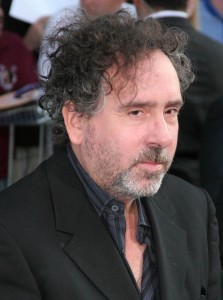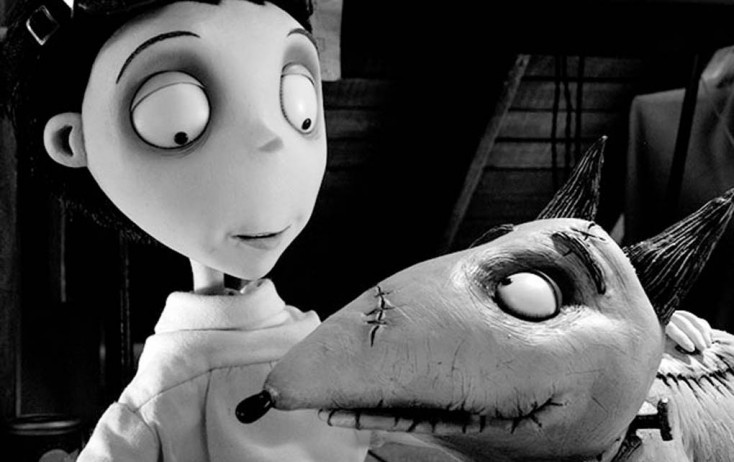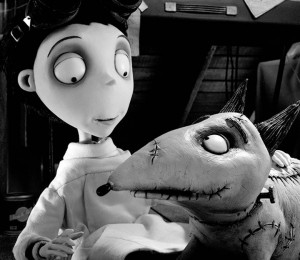
Tim Burton at the “Frankenweenie” Los Angeles Premiere held at the El Capitan Theatre in Hollywood, CA. The event took place on Monday, September 24, 2012. Photo by Steven Lam_Pacific Rim Photo Press.
By ANGELA DAWSON
Front Row Features
ANAHEIM, Calif.—Tim Burton has come a long way since he made his original “Frankenweenie,” short film about a boy named Victor who brings his dead dog back to life via a good jolt of electricity, an homage to Mary Shelley’s horror classic “Frankenstein” and the 1931 film. That live action short, which was supposed to be shown before the 1984 re-release of Disney’s “Pinocchio,” was considered by studio executives to be too scary for children and was ultimately shelved before hitting theaters.
In the intervening years, Burton has become one of Hollywood’s most well-respected and successful directors, an Oscar nominated filmmaking for “Corpse Bride,” and his unique style has inspired a generation of young filmmakers.
So what does the genius behind hits like “Beetlejuice,” “Sweeney Todd,” “Corpse Bride” and “Alice in Wonderland” do for an encore? He remakes his horror short as a full-length animated feature, and at Disney once again.
Just steps away from Disneyland, where visitors are treated to Burton’s “Nightmare Before Christmas”-inspired Halloween season redo of the Haunted Mansion, Burton is talking up his “Frankenweenie” 2.0 in his low-key way.
It’s obvious that this stop-motion animated feature is near and dear to his heart, and he is more than happy with the way it turned out.
Q: Having a project gestating as long as this has, is there a postpartum period?
Burton: I’m getting to that point. It’s been such a long process, especially for the animators. They’re the ones who are long suffering in a dark room for a couple of years. So many people put in so much work into it and I feel good about it.
Q: How important was it to keep the original short intact?
Burton: That was the original idea. Being an animator back then, I loved the idea of doing it live-action, which was fun and exciting. It got me into a whole other world, which was great. But loving stop-motion and going back and looking at the original drawings, I started thinking about other aspects of that time (such as) the other kids in school. I remember all the weird kids, my school and even the architecture of (my California hometown) Burbank, so the idea of going to the original drawings and expanding it to other monsters with the House of Frankenstein motif, in black and white and 3D, made it feel like a different project—even though the roots of it are the same.
Q: How much is the Victor Frankenstein character based on your childhood?
Burton: This is a memory piece. A lot of it involves feelings I had at the time, and I remember, even the way the classroom was, and the other kids, everything was, teachers I remembered. So I tried to personalize everything, even down to the settings. It was much more like Burbank and actually the park and the house. Everything was more personalized. You can’t necessarily do that with a lot of projects, but this one was so much based on all sorts of memories, so that’s what I tried to put into it.
Q: Does that include the dog?
Burton: Oh, yeah. My dog didn’t look like that, but my feelings about my dog—that was the whole genesis of what the project was about. That was based on real feelings and real emotions at the time, and a real sense of relationship.
Q: I loved seeing the classic movie monster Rodan make an appearance in this.
Burton: The movie is filled with (old monster movie) references. (But) so many people don’t know those references, so I tried to not make it reference-dependent, for kids or people who don’t know those movies. I tried to make it not the only reason why you would enjoy the film. Homages too are about the feeling of it as opposed to having to know every reference to still get the flavor of what those movies were.
Q: Were there any references that you wanted to use but figured they were too obscure?
Burton: No. I never made it about something you have to know. Like I said, I tried to keep it on an emotional level in terms of a story about a boy and his dog. So those (reference) elements are just part of the flavor of it as opposed to the overriding factor.
Q: Can you say how those old monster movies affected you?
Burton: Those are the films that spoke to me. Some people like musicals, westerns—everybody’s got their thing. For me, those (horror) movies spoke to my emotional life in the sense that if you felt weird or outcast or lonely, you could relate to the monsters. Most of the monsters were misunderstood characters and I think a lot of children feel that way. It was easy to identify with those characters and they psychologically guide you through it. You see Vincent Price or the Roger Corman films and you see the tortured soul. They help you through your emotional life as you’re growing up and you don’t understand everything on an intellectual level.
Q: How do you see this story now that you’re in your 50s?
Burton: Whatever feelings you had as a child, you never really lose them. If you feel a certain way, it doesn’t matter what happens to you later in life. You retain those feelings. It’s always been important to remember seeing things in a different way.
Q: Why did you cast Winona Ryder as the voice of the schoolgirl Elsa?
Burton: I asked her to do the voice of a kid because that’s how she still sounds. I knew she could do it. She hasn’t really changed much. I love working with her and I haven’t worked with her in many years, so this was a small thing and because it was a project that means a lot to me it was nice to have somebody like her who I love.
Q: You tapped other actors you’ve worked with before to work on this.
Burton: Yes. Catherine (O’Hara, who provides the voice of Mrs. Frankenstein) and Martin (Short, who provides the voice of Mr. Frankenstein) and Martin (Landau, who provides the voice of influential science teacher Mr. Rzykruski). It was important on this to have that type of connection and it made it more special to me. The people you love, you can see them every day, or you may not see them for a couple of years, and it it’s like I saw them yesterday. Those are people that mean a lot to you and you still have that connection.
Q: How did you decide on 14-year-old Charlie Tahan to provide the voice of Victor?
Burton I remember I first heard Charlie’s voice and looking at the model, and I just thought there was a gravity to it. It’s almost like it’s a live-action film not like an animated film. I didn’t have him look at horror movies or anything, because it wasn’t about that. It’s just him being him. And Atticus (Shaffer, who plays E Gore) was great. He kind of got the whole Peter Lorre thing. And it was funny mixing up the voices—kids and adults—because for some reason it all somehow strangely fit.
Q: What were the different feelings for you during this whole process versus who you were for the “Frankenweenie” short?
Burton: It was different. I was at a different point in my career. In some ways, I’m grateful that the short was live-action. As an animator, if I’ve done it animated back then, I probably wouldn’t have gotten the opportunity to do live-action. Looking at the drawings and thinking about the story of Frankenstein bringing an inanimate object back to life, the stop-motion process is a purer notion of the idea in the sense of the medium and the story mixing in the right way.
Q: What makes a Tim Burton film so special?
Burton: I wouldn’t know. I don’t think about that kind of stuff. You try to spend your life trying to become a human being and then you become a thing. “This is what you do,” people say. I try not to think about it. That’s why I don’t read things about myself. I don’t want to think, “This is what I do. This is my style.” It’s better off to not think of yourself as a thing.
Q: How did your perspective shift from being a young guy who is into the pop culture stuff that you’re in, meeting somebody like Vincent Price?
Burton: I’ve been lucky with everybody I’ve been inspired by. Vincent Price was that way. Ray Harryhausen is that way. Christopher Lee was that way. So is Martin Landau. I’ve been very lucky to meet those people and they have a very similar dynamic of being an amazing graceful people, which sets you up for life when you get that good experience.






